我的位置:設(shè)計(jì)本
>
精選工裝
>風(fēng)合睦晨/金科集美天宸銷售中心
風(fēng)合睦晨/金科集美天宸銷售中心
參考造價(jià):暫未填寫|
空間:售樓中心|
面積:1220平米|
瀏覽數(shù):2878
案例簡(jiǎn)介 Case description
“竹密豈妨流水過(guò),山高哪礙野云飛”——古人的這兩句偈語(yǔ)為我們勾勒出了中國(guó)人所持有的一種獨(dú)特的充滿智慧的精神向往以及一種擺脫生活羈絆的人生渴求。這種向往與渴求可以歸結(jié)為對(duì)于超然物外、抱樸守真、閑適從容的生活態(tài)度的回歸境界。 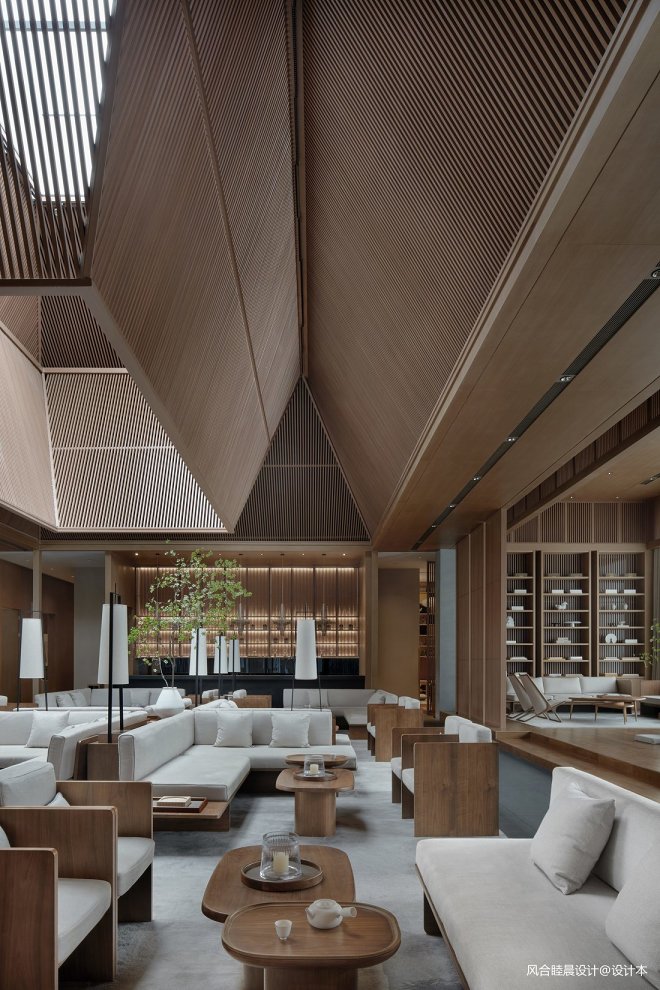
自然的回歸以及詩(shī)意的棲居——是這次風(fēng)合睦晨為金科棗莊集美天宸銷售中心設(shè)計(jì)時(shí)所要傳遞和表達(dá)的主要精神訴求。尋回中國(guó)式的清幽雅致狀態(tài),讓節(jié)奏慢下來(lái),過(guò)一種真正健康的閑適和覺醒的生活。
The return to nature and capturing of poetic flavor is the core statement and emotional appeal in the design by Fenghemuchen for the sales center of the Jinke JiMeiTianChen in Zaozhuang. They sought to recreate the tranquility and elegance of traditional Chinese style, and to live a truly healthy and awakened life by slowing down the paces.
The return to nature and capturing of poetic flavor is the core statement and emotional appeal in the design by Fenghemuchen for the sales center of the Jinke JiMeiTianChen in Zaozhuang. They sought to recreate the tranquility and elegance of traditional Chinese style, and to live a truly healthy and awakened life by slowing down the paces.
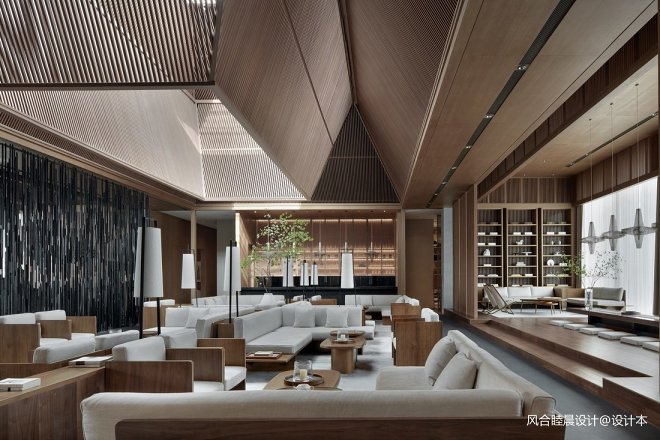
通過(guò)對(duì)造物、文化、生活方式的汲取沿襲,打造出獨(dú)有的東方人居審美表現(xiàn)體系。用最自然的方式,將健康療愈的理念與感受傳達(dá)給置身空間中的每一個(gè)人。漫步其中,卸下所有的社會(huì)屬性, 讓精神得以放松,壓力得以排解。
Drawing inspiration from traditional Chinese craftsmanship, culture and lifestyle, the designers have managed to find a unique way in expressing aesthetics of oriental residences. The idea of wellbeing and healing is conveyed to everyone entering the space in the most natural way, allowing them to turn away from stress and burdens in life for a moment and getting relaxed.
Drawing inspiration from traditional Chinese craftsmanship, culture and lifestyle, the designers have managed to find a unique way in expressing aesthetics of oriental residences. The idea of wellbeing and healing is conveyed to everyone entering the space in the most natural way, allowing them to turn away from stress and burdens in life for a moment and getting relaxed.
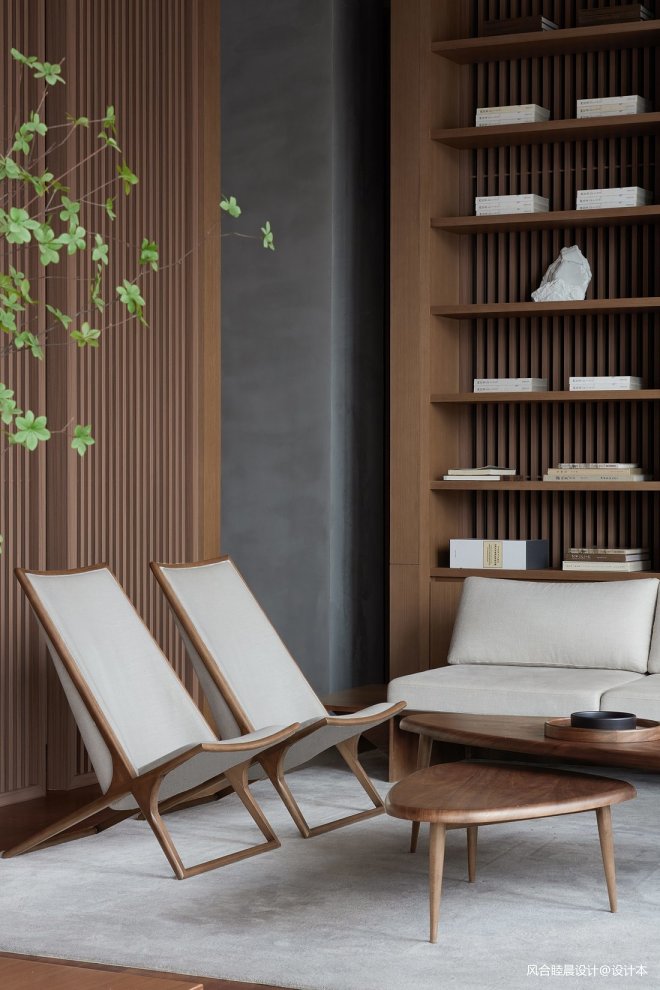
另外,基于對(duì)中國(guó)古典的人文精神和齊魯文化質(zhì)樸氣質(zhì)重新深入詮釋,設(shè)計(jì)師持續(xù)在空間中探索自然東方的設(shè)計(jì)語(yǔ)言,力求將空間秩序進(jìn)行重新梳理和解構(gòu),以現(xiàn)代的設(shè)計(jì)語(yǔ)匯呈現(xiàn)出全新的空間感受。試圖構(gòu)建出一處能夠洗凈心垢,重返心靈詩(shī)境的精神處所,也同時(shí)構(gòu)筑出一件充滿藝術(shù)靈性及自我感悟的回歸東方文化意境的空間設(shè)計(jì)作品。
In addition, based on the in-depth interpretation of Chinese classical humanism and ancient Qilu cultural heritage, the designers, keeping exploring the authentic oriental design language throughout the space, make each and every effort to reorganize and deconstruct orders in this space, and present a new feeling with modern design language. In an attempt to create a spiritual space that can purify our minds and lead a way to return to a poetic world, they are ambitious to build a space featuring oriental artistic and cultural elements full of artistic spirituality and self-perception.
In addition, based on the in-depth interpretation of Chinese classical humanism and ancient Qilu cultural heritage, the designers, keeping exploring the authentic oriental design language throughout the space, make each and every effort to reorganize and deconstruct orders in this space, and present a new feeling with modern design language. In an attempt to create a spiritual space that can purify our minds and lead a way to return to a poetic world, they are ambitious to build a space featuring oriental artistic and cultural elements full of artistic spirituality and self-perception.

整體的空間構(gòu)想來(lái)自于傳統(tǒng)的“合”與“舍”的概念,“合”是圍合、聚合、合則成體的意思,“舍”是居所、家的概念,也有取舍、釋然的意念。
The overall conception of the space is derived from the Chinese characters of “合” and “舍”, “合” means “completeness, convergence and reunion”, while “舍” has two meanings: one is a residence, and another one is the concept of making a choice and feeling a sense of relief.
The overall conception of the space is derived from the Chinese characters of “合” and “舍”, “合” means “completeness, convergence and reunion”, while “舍” has two meanings: one is a residence, and another one is the concept of making a choice and feeling a sense of relief.

為了尋求“山水聚合、藏風(fēng)得水”的傳統(tǒng)建筑理念,空間中被并列地置入大型的木質(zhì)構(gòu)架作為整體建構(gòu)和分割空間的主體骨骼造型, 形成“舍”的框架結(jié)構(gòu)部分。
In order to leverage the traditional Fengshui architectural wisdom of “captivating the spirit of mountain and water for storing the good things”, large wooden frames are placed in sequence throughout the space as the main structure and space division, forming a framework structure resembling the character “舍”.
In order to leverage the traditional Fengshui architectural wisdom of “captivating the spirit of mountain and water for storing the good things”, large wooden frames are placed in sequence throughout the space as the main structure and space division, forming a framework structure resembling the character “舍”.

構(gòu)架的頂部吸收并運(yùn)用了中國(guó)古典殿閣與井亭的“盝頂”建筑造型樣式,形成四角上揚(yáng)收合的形態(tài),凸顯出生命氣息與能量聚合的理念,同時(shí)在聚合的頂部留出可呼吸的天窗氣口 , 充分地吸納天地靈氣和流轉(zhuǎn)的太陽(yáng)光線。從而形成“舍”的傾斜式頂部結(jié)構(gòu)部分。“盝頂”的運(yùn)用,產(chǎn)生出高低起伏、聚合離散的空間節(jié)奏,也營(yíng)造出林泉丘壑、山野幽僻的悠遠(yuǎn)意境。
The roof of the space is inspired by the traditional architectural form of “l(fā)uding”, which is primarily used in Chinese pavilions and palaces. It is a rectangular roof and high rising tilts leaning towards the center on all four corners, representing the convergence of vitality and energy. At the same time, a skylight is made at the top part where the elements converge, so as to let in the “Qi” and sunlight. This forms the inclined top structure part of character “舍”. The use of “l(fā)uding” not only produces the spatial rhythm of ups and downs, convergence and dispersion, but also creates a sense of seclusion.
The roof of the space is inspired by the traditional architectural form of “l(fā)uding”, which is primarily used in Chinese pavilions and palaces. It is a rectangular roof and high rising tilts leaning towards the center on all four corners, representing the convergence of vitality and energy. At the same time, a skylight is made at the top part where the elements converge, so as to let in the “Qi” and sunlight. This forms the inclined top structure part of character “舍”. The use of “l(fā)uding” not only produces the spatial rhythm of ups and downs, convergence and dispersion, but also creates a sense of seclusion.

另外,針對(duì)主體沙盤區(qū)和深度洽談區(qū)等主要的空間場(chǎng)域,上挑的頂部能量再次被聚合起來(lái),以同樣聚合的造型再次向下方的功能承接區(qū)域傳遞能量,同時(shí)起到過(guò)濾上部光線及凝聚并傳導(dǎo)能量和氣息的功能。
In addition, for main areas such as the sand table and the in-depth negotiation area, tilted roof is again used to converge energy, and then transmit energy to the lower functional area. At the same time, they serve the purpose of screening the light from above, and bringing energy and Qi together.
In addition, for main areas such as the sand table and the in-depth negotiation area, tilted roof is again used to converge energy, and then transmit energy to the lower functional area. At the same time, they serve the purpose of screening the light from above, and bringing energy and Qi together.

空間以木色和素水泥灰為主調(diào)。設(shè)計(jì)語(yǔ)言的運(yùn)用和材質(zhì)選用上盡力做到簡(jiǎn)單平實(shí)少而純粹。木質(zhì)格柵造型被大面積的運(yùn)用在空間當(dāng)中作為各個(gè)功能區(qū)域的分割與間隔,讓空間既通透又讓各個(gè)功能區(qū)間隔有致。看似簡(jiǎn)單的設(shè)計(jì)除卻了表面的粉飾,簡(jiǎn)約簡(jiǎn)樸卻引人入勝。原木材質(zhì)的運(yùn)用營(yíng)造出安靜溫暖的心靈療愈氛圍,從而起到平復(fù)心靈的作用。設(shè)計(jì)手法看似平淡卻釋放了材質(zhì)本身的魅力,讓空間形成一種不事張揚(yáng)的氣場(chǎng)。將具象的空間以抽象化的方式打造出簡(jiǎn)約而樸素、靜謐而無(wú)常的空靈氣息。
The space is dominated by wooden and plain cement grey in color. The design language and material selection are kept simple, plain, minimal and pure. Wooden grilles are widely used as space division between different functional areas, so that the space is both transparent and orderly between each functional area. The deceptively simple design has got rid of pompous decoration, creating a modest yet fascinating style. Using wood creates a calm and warm atmosphere for healing the mind. The seemingly dull design highlights the charm of the materials, creating unobtrusive atmosphere. The concrete space is transformed into a simple, tranquil, flowing and ethereal environment with an abstraction approach.
The space is dominated by wooden and plain cement grey in color. The design language and material selection are kept simple, plain, minimal and pure. Wooden grilles are widely used as space division between different functional areas, so that the space is both transparent and orderly between each functional area. The deceptively simple design has got rid of pompous decoration, creating a modest yet fascinating style. Using wood creates a calm and warm atmosphere for healing the mind. The seemingly dull design highlights the charm of the materials, creating unobtrusive atmosphere. The concrete space is transformed into a simple, tranquil, flowing and ethereal environment with an abstraction approach.

整座建筑的外圍為大面積的水景環(huán)繞,設(shè)計(jì)師順勢(shì)也將水的概念自然地導(dǎo)入室內(nèi),枯山水和靜水水缽的運(yùn)用為空間帶來(lái)“溪花與禪意,相對(duì)亦忘言”的空靈意境。清澈的流水散發(fā)出空空聲響,于清靜處浸潤(rùn)人心。
The building is surrounded by large areas of waterscape. The designers introduce the water concept into the interior naturally. The use of dry rock landscape and still water bowl creates an ethereal touch of “juxtaposing of wild flower and Zen state”, while the lyrical sound of running water has a calming and healing power to the heart in this serene place.
The building is surrounded by large areas of waterscape. The designers introduce the water concept into the interior naturally. The use of dry rock landscape and still water bowl creates an ethereal touch of “juxtaposing of wild flower and Zen state”, while the lyrical sound of running water has a calming and healing power to the heart in this serene place.

在入口門庭處與主要的深度洽談區(qū)之間,設(shè)計(jì)師特別設(shè)計(jì)了一面大型的藝術(shù)裝置隔斷,隔斷由密集的炭燒木條以縱向的排列組合橫向延展而成,進(jìn)一步的傳達(dá)出“竹密豈妨流水過(guò)”及“四面竹樹環(huán)合”的空間虛隱意象。
Between the entrance porch and the main in-depth negotiation area the designers specially set up a large art installation, which is made of a series of dense burned wood strips arranged vertically, further conveying the spatial image of “however dense bamboo bushes are, they cannot hinder the flowing waters” and “surrounded by bushes on all sides”.
Between the entrance porch and the main in-depth negotiation area the designers specially set up a large art installation, which is made of a series of dense burned wood strips arranged vertically, further conveying the spatial image of “however dense bamboo bushes are, they cannot hinder the flowing waters” and “surrounded by bushes on all sides”.

設(shè)計(jì)師使用這樣的當(dāng)代藝術(shù)視覺元素探尋中國(guó)傳統(tǒng)的精神文脈,延續(xù)著以意取象的藝術(shù)設(shè)計(jì)手法,釋放出特有的靈性與詩(shī)情,于無(wú)形中滿足和激發(fā)了我們內(nèi)心積存已久的審美文化需求以及情感共鳴。將空間感知與自然靈性、傳統(tǒng)感悟與當(dāng)代審美巧妙融合,于傳承中步入升華。
By using such contemporary visual elements to represent the spiritual context of Chinese culture, the designers inherit traditional art creation technique of taking images for meaning to unlock the unique inspiration and artistic conception. It subtly meets our long-standing aesthetic and cultural needs, striking a resonant cord in emotion. The combination of space perception with natural inspiration, traditional experience with contemporary aesthetics will bring our cultural inheritance to a higher level.
By using such contemporary visual elements to represent the spiritual context of Chinese culture, the designers inherit traditional art creation technique of taking images for meaning to unlock the unique inspiration and artistic conception. It subtly meets our long-standing aesthetic and cultural needs, striking a resonant cord in emotion. The combination of space perception with natural inspiration, traditional experience with contemporary aesthetics will bring our cultural inheritance to a higher level.

在完成功能需求的同時(shí),設(shè)計(jì)師將可見的有形空間轉(zhuǎn)化為無(wú)形的精神與情感痕跡,在樸素與靜謐中體會(huì)獨(dú)特的詩(shī)情畫意。打破傳統(tǒng)與現(xiàn)代、夢(mèng)想與現(xiàn)實(shí)的邊界,將美學(xué)與生活合而為一。為生活在忙碌、嘈雜的現(xiàn)代都市里的人們提供了一處虛實(shí)相生、繁簡(jiǎn)相宜,能夠回歸自然與人性精神本位,再次找回自身真正內(nèi)在情性的靈性空間。讓空間與自然融合,舊的文脈與新的元素共生,再加入現(xiàn)代的構(gòu)思構(gòu)建出親切閑適、清靜自性,讓生命與靈魂得以溝通的藝術(shù)空間。
In addition to fulfilling the functional requirements, the designers transform the tangible space into intangible spiritual and emotional touches, and convey a unique poetic and picturesque feeling in sheer simplicity and tranquility. Breaking the boundary between tradition and modernity, dream and reality, they manage to combine aesthetics with life, providing an idyllic, minimal, natural and spiritual retreat for people living in the hustle and bustle of modern metropolis to find and return to their true self. This is where space and nature merge, old heritage and new elements coexist. With the addition of a modern touch, they build an intimate, relaxed, comfortable, quiet and natural artistic space where our body and soul can link and align.
In addition to fulfilling the functional requirements, the designers transform the tangible space into intangible spiritual and emotional touches, and convey a unique poetic and picturesque feeling in sheer simplicity and tranquility. Breaking the boundary between tradition and modernity, dream and reality, they manage to combine aesthetics with life, providing an idyllic, minimal, natural and spiritual retreat for people living in the hustle and bustle of modern metropolis to find and return to their true self. This is where space and nature merge, old heritage and new elements coexist. With the addition of a modern touch, they build an intimate, relaxed, comfortable, quiet and natural artistic space where our body and soul can link and align.

平面圖
項(xiàng)目名稱:金科棗莊集美天宸銷售中心
硬裝設(shè)計(jì):風(fēng)合睦晨空間設(shè)計(jì)
軟裝設(shè)計(jì):風(fēng)合睦晨空間設(shè)計(jì)
軟裝執(zhí)行:AOD
設(shè)計(jì)師:陳貽 張睦晨
撰文:陳貽
項(xiàng)目地址:山東棗莊
項(xiàng)目面積:1220m2
項(xiàng)目完成時(shí)間:2020年04月
攝影:孫翔宇
項(xiàng)目名稱:金科棗莊集美天宸銷售中心
硬裝設(shè)計(jì):風(fēng)合睦晨空間設(shè)計(jì)
軟裝設(shè)計(jì):風(fēng)合睦晨空間設(shè)計(jì)
軟裝執(zhí)行:AOD
設(shè)計(jì)師:陳貽 張睦晨
撰文:陳貽
項(xiàng)目地址:山東棗莊
項(xiàng)目面積:1220m2
項(xiàng)目完成時(shí)間:2020年04月
攝影:孫翔宇
設(shè)計(jì)本官方微信
掃描二維碼,即刻與本本親密互 動(dòng),還有更多美圖等你來(lái)看!
免責(zé)聲明:本網(wǎng)站部分內(nèi)容由用戶自行上傳,如權(quán)利人發(fā)現(xiàn)存在誤傳其作品情形,請(qǐng)及時(shí)與本站聯(lián)系。
?2012-現(xiàn)在 shejiben.com,All Rights Reserved.

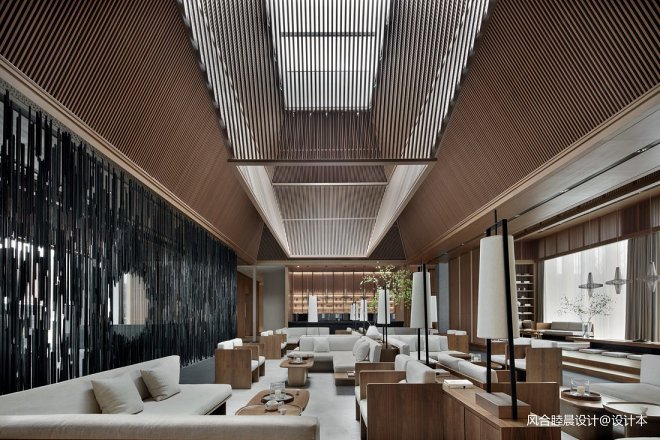
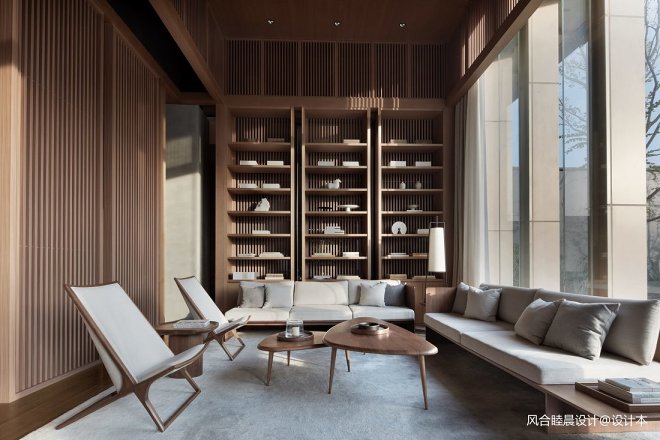
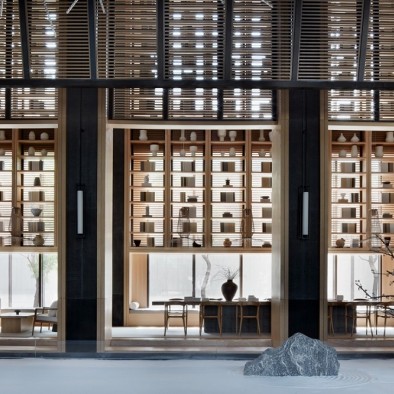
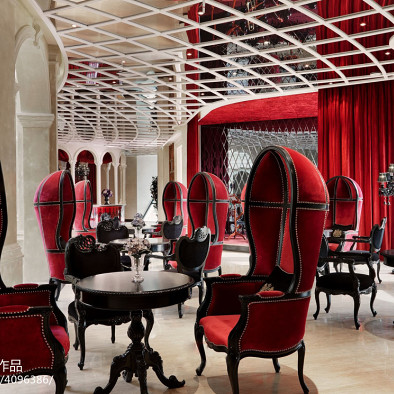
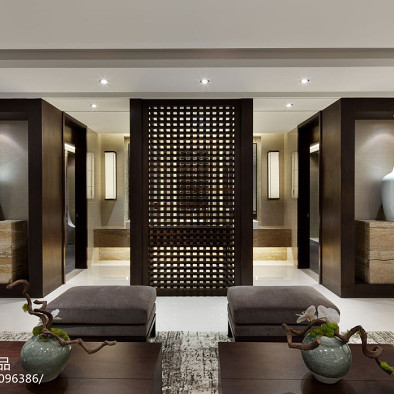
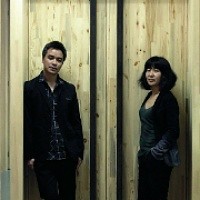

評(píng)論( 0)
查看更多評(píng)論